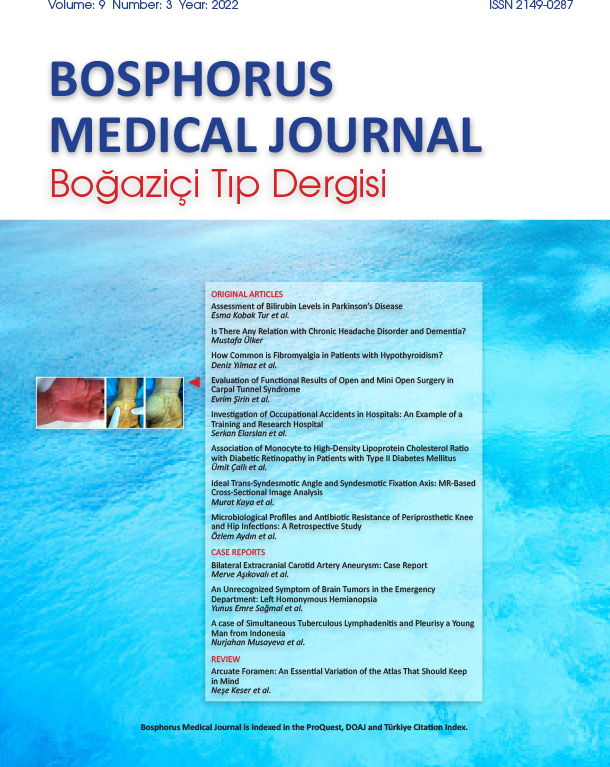Arcuate Foramen: An Essential Variation of the Atlas That Should Keep in Mind
Neşe Keser1, Arzu Atıcı2, Barış Yılmaz3, Esin Derin Çiçek4, Ali Fatih Ramazanoğlu5, Ali Demiraslan11Health Sciences University, Fatih Sultan Mehmet Training and Research Hospital, Department of Neurosurgery, Istanbul, Türkiye2Health Sciences University, Fatih Sultan Mehmet Training and Research Hospital, Clinic of Physical Medicine and Rehabilitation, Istanbul, Türkiye
3Health Sciences University, Fatih Sultan Mehmet Training and Research Hospital, Orthopedics and Traumatology Clinic, Istanbul, Türkiye
4Health Sciences University, Fatih Sultan Mehmet Training and Research Hospital, Clinic of Radiology, Istanbul, Türkiye
5Health Sciences University, Ümraniye Training and Research Hospital, Neurosurgery Clinic, Istanbul Türkiye
The arcuate foramen (AF), one of the variations of the first cervical vertebra (atlas), is localized on the vertebral artery (VA) sulcus, and computed tomography is the gold standard in its diagnosis. AF has complete and incomplete types, and its incidence varies according to societies, ethnic groups, and examination methods, ranging from 1% to 68%. The third segment of the VA, the suboccipital nerve, the perivascular sympathetic plexus, and the vertebral venous plexus pass through it. It gives symptoms according to the degree of pressure on the structures passing through it, and the complete type is more likely to give clinical findings. AF is also important because of its potential to cause VA dissection during neck traumas and surgical procedures applied to the upper cervical region. In this study, the latest literature was reviewed, and the clinical importance of AF was summarized in the light of scientific evidence.
Keywords: Anatomical variation, arcuate foramen, atlas, cervical spine.Arkuat Foramen: Atlasın Hatırlanması Gereken Önemli Bir Varyasyonu
Neşe Keser1, Arzu Atıcı2, Barış Yılmaz3, Esin Derin Çiçek4, Ali Fatih Ramazanoğlu5, Ali Demiraslan11Sağlık Bilimleri Üniversitesi, Fatih Sultan Mehmet Eğitim ve Araştırma Hastanesi, Beyin ve Sinir Cerrahisi Kliniği, İstanbul, Türkiye2Sağlık Bilimleri Üniversitesi, Fatih Sultan Mehmet Eğitim ve Araştırma Hastanesi, Fiziksel Tıp ve Rehabilitasyon Kliniği, İstanbul, Türkiye
3Sağlık Bilimleri Üniversitesi, Fatih Sultan Mehmet Eğitim ve Araştırma Hastanesi, Ortopedi ve Travmatoloji Kliniği, İstanbul, Türkiye
4Sağlık Bilimleri Üniversitesi, Fatih Sultan Mehmet Eğitim ve Araştırma Hastanesi, Radyoloji Kliniği, İstanbul, Türkiye
5Sağlık Bilimleri Üniversitesi, Ümraniye Eğitim ve Araştırma Hastanesi, Beyin ve Sinir Cerrahisi Kliniği, İstanbul, Türkiye
Birinci servikal vertebranın (atlas) varyasyonlarından olan arkuat foramen (AF) vertebral arter sulkusu üzerinde lokalizedir ve tanısında bilgisayarlı tomografi altın standarttır. Komplet ve inkomplet tipleri olan arkuat foramenin rastlanma sıklığı toplumlara, etnik gruplara ve inceleme yöntemine göre değişmekte olup %1-68 arasında değişen oranlar bildirilmektedir. İçinden, vertebral arterin üçüncü segmenti, suboksipital sinir, perivasküler sempatik pleksus ve vertebral venöz pleksus geçmektedir. Arkuat foramen içinden geçen yapılara yaptığı basının derecesine göre bulgu vermekte olup komplet tipte olanının klinik bulgu verme olasılığı daha yüksektir. Boynu aşırı zorlayan travmalar ve üst servikal bölgeye uygulanan cerrahi girişimler esnasında vertebral arter diseksiyonuna neden olma potansiyelinin yüksek olması nedeniyle arkuat foramen ayrıca önem taşımaktadır. Bu çalışmada son literatürler de incelenip bilimsel kanıtlar eşliğinde arkuat foramenin klinik önemi özetlenmiştir.
Anahtar Kelimeler: Anatomik varyasyon, arkuat foramen, atlas, servikal omurga.Manuscript Language: Turkish




















